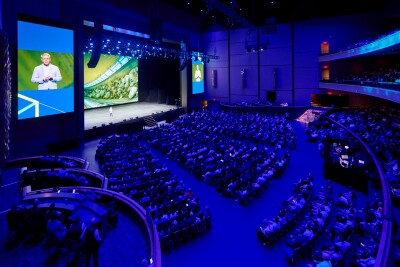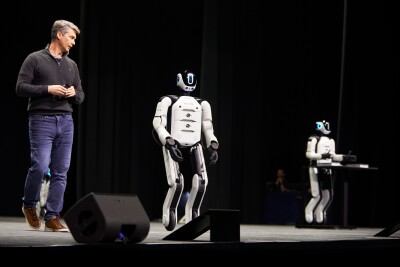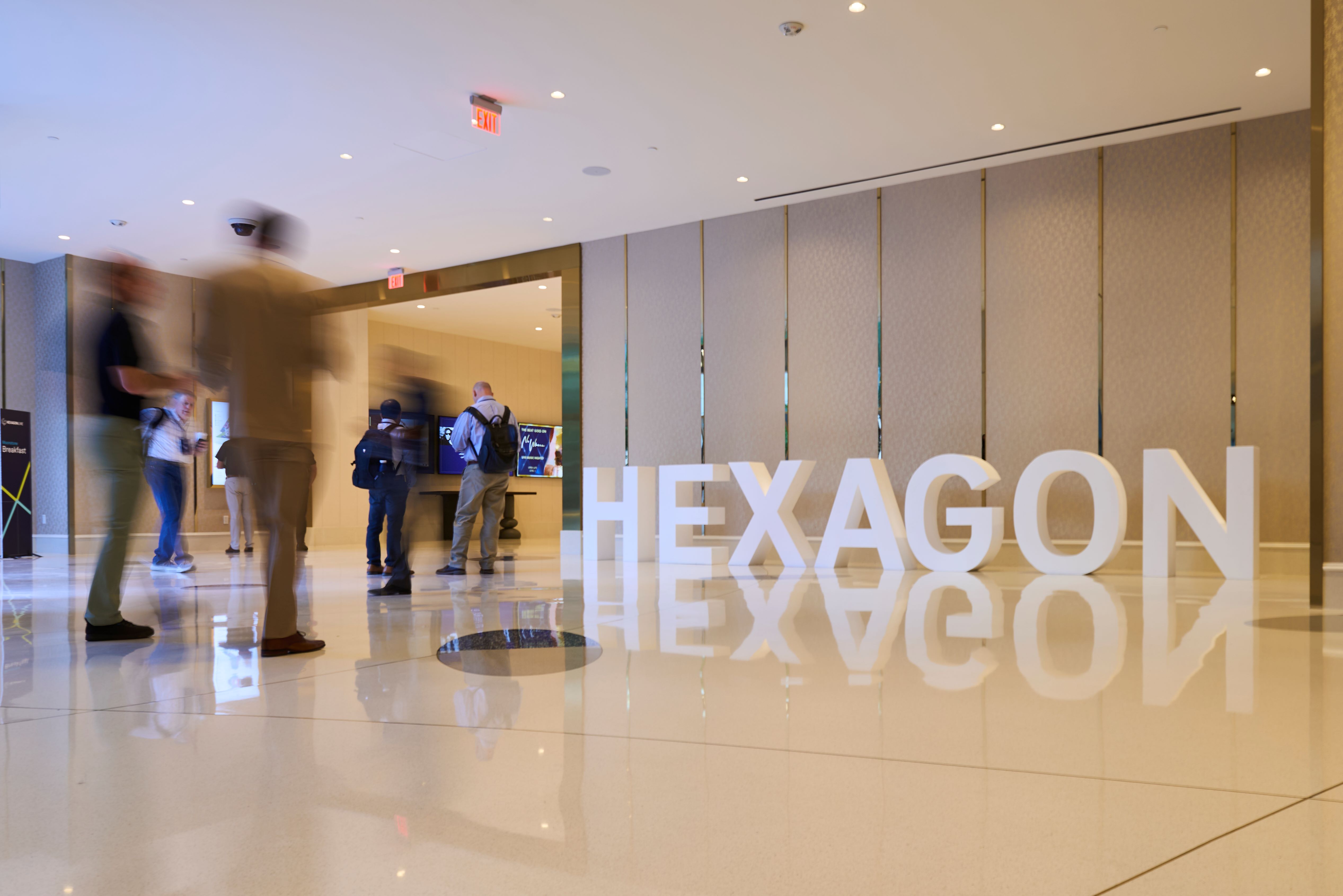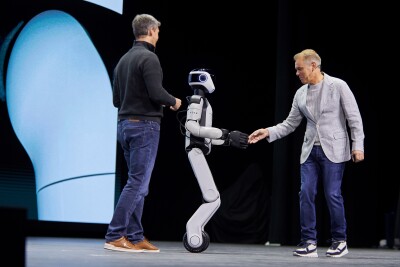Last week at the Fontainebleau hotel in Las Vegas, Nevada, geospatial, manufacturing, and other professionals from across the world came together for the Hexagon Live Global conference, organized by Hexagon for its users and other professionals across the sectors they cover. The event, taking place over the course of three days, featured over 3,000 attendees representing 59 countries, according to a spokesperson. The show floor – known as “The Zone” – was rife with Hexagon products and organizational experts in individual fields, along with a handful of sponsor companies exhibiting. Additionally, the three-day event featured a busy conference schedule with a series of presentations and case studies covering how customers are using this technology in their workflows, and where they see the industry heading.
Geo Week News was in attendance for this year’s event, taking in a number of sessions and having plenty of interesting conversations with both Hexagon experts as well as other industry professionals throughout the week. You can expect plenty of our coverage to come out from the event over the next week or so, including individual conversations and session highlights, but today we will give a brief overview of what we felt were the three biggest takeaways of this year’s Hexagon Live.
Measurement Remains the Core
As we’ll cover a little bit below, there was a lot of this conference that very much inspired the feeling that the future is finally starting to arrive. A lot of the technology that was unveiled, and the biggest announcements, felt right out of science fiction. What stood out as an overarching theme, however, was the fact that the basics are certainly not dead, and if anything they are as important as ever. For Hexagon, that all revolves around measurement. The opening keynote of the event, led by the company’s chairman Ola Rollén, was entitled Beyond Measure and revolved entirely around this idea.

In an industry like this one where innovation is happening so rapidly and it’s seemingly a full-time job just to keep up with the change transforming the sector, it can be easy to lose grasp of the fundamentals that form the basis of the work. All of these new technologies, at the end of the day, come back to bringing precise measurements. As part of his presentation, Rollén ran through the history of measurements, and how things have been adjusted when the needs of the time called for them. Starting with the Egyptians building the pyramids, moving up to the medieval farmers, and going all the way up to today, measurements are always at the core of society.
Today, of course, measurements are a bit more sophisticated than the Egyptian cubit, which Rollén points out was simply the distance between the elbow and the tip of the middle finger. Now, we’re talking about accuracy in the centimeters with measurements based in space, and millimeter-level accuracy from terrestrial-based systems. Conversations walking around the show floor ultimately talked about that accuracy as the central piece of the discussion. The technology couldn’t have been conceived of thousands of years ago, of course, but the ultimate goal remains the same: At the end of the day, building the critical infrastructure of the today’s society relies on highly accurate measurement.
Is it the Age of Robotics?
Now that we have the basics out of the way, we can move on to that futuristic piece mentioned above: Robots. If you had seen anything on social media about this event, it would have felt like a safe bet that it would’ve been AEON, Hexagon’s new humanoid robot. Officially introduced and unveiled on the keynote stage, they were clear that they feel like this is the start of a new age where robots can be used for a number of different tasks in the right environment, and that this isn’t simply a cool thing for the sake of having a cool thing. Arnaud Robert, Hexagon’s President of Robotics, explicitly said that they aren’t going to show off their dancing skills on stage. It was all business.
Later in that first day of the show, they had a more extended session showing off what AEON can do today, which clearly revolved around manufacturing and warehouse environments. Built with wheels instead of feet, that kind of controlled, indoor environment is necessary. AEON was able to sort objects, converse, and scan an asset – in the demonstration, it was a car door – while keeping track of areas that had or hadn’t been scanned. In the short term, AEON doesn’t seem to have a major impact on the geospatial or AEC sectors, but it does have the capability of performing reality capture tasks both by holding a scanner and with built-in sensors. It’s not hard to see a scenario down the road – with a different form factor to better handle more complex environments – to see either a similar product or an iteration of AEON working in this field, something of a natural next step from Spot the Dog.

It wasn’t just this futuristic, newly introduced robot that stood out in the robotics space last week, though. Geo Week News also saw a presentation from representatives at AECOM, who showed off how they are using robots to help with inspection workflows in pipes. With custom-built rigs, they were able to perform autonomous scanning workflows with different levels of sensors, and even customized different form factors for different-sized pipes and even wetter environments. AEON created the headlines, and for perfectly valid reasons, but this presentation was a strong reminder that robots aren’t just the future – they’re creating value right now.
Digital Twins: Valuable, but Still Murky
There’s no bigger buzzword across every industry right now than “AI,” but in the geospatial industry, “digital twin” is not too far behind. Unsurprisingly, it was a big topic of discussion throughout this event, coming up in a number of sessions. This makes sense for a Hexagon event, as those measurements discussed above, and the overall dataset that is collected with their tools, often form the basis of these digital twins. Geo Week News spoke with Uwe Jasnoch and Joris Schouteden about the company’s safety, infrastructure, geospatial division, and Luciad, respectively, and the topic of digital twins was a big part of the conversation. They spoke to the very tangible value of these tools, particularly for governments and those in industries like construction, and how important the data is to form a proper base for these tools.
There was, additionally, a big piece of news coming out of the conference with a new spinoff of Hexagon, known as Octave. The new company, which will be based in the U.S., is going to take on a lot of the software solutions under the Hexagon umbrella, and one of our biggest takeaways was that it will look to address the entire lifecycle of an asset. While it wasn’t explicitly said, that feels like a new company that will be looking to address this growing digital twin market.
There was also a fascinating presentation from Logan McGuinness, a VDC manager at The Weitz Company, about how they are working with clients who are asking about digital twins. We’ll have more on this specific presentation in the coming days, but it was a good look at how there is often a disconnect between those asking for a digital twin, what they are actually looking for, and what it means from a cost, technology, and time perspective to put it all together. It was clear, ultimately, that digital twins are a tangible value today, but that we are still in the nascent stages of that development, and people need to be educated on what it means, and what level of information they need for their workflows.






